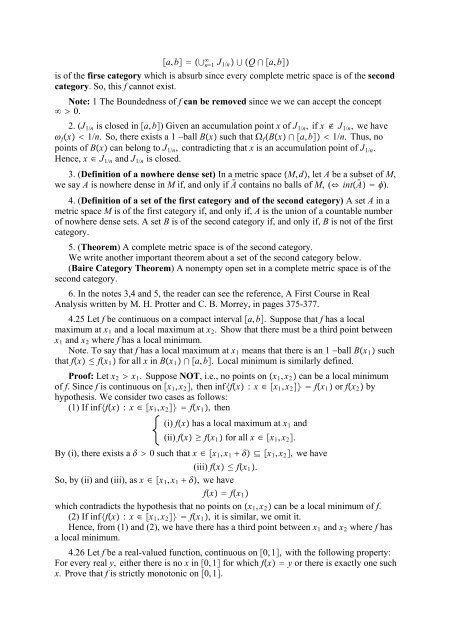The Real And Complex Number Systems
The Real And Complex Number Systems
The Real And Complex Number Systems
Create successful ePaper yourself
Turn your PDF publications into a flip-book with our unique Google optimized e-Paper software.
a, b <br />
n1 J 1/n Q a, b<br />
is of the firse category which is absurb since every complete metric space is of the second<br />
category. So, this f cannot exist.<br />
Note: 1 <strong>The</strong> Boundedness of f can be removed since we we can accept the concept<br />
0.<br />
2. (J 1/n is closed in a, b) Given an accumulation point x of J 1/n ,ifx J 1/n ,wehave<br />
f x 1/n. So, there exists a 1 ball Bx such that f Bx a, b 1/n. Thus, no<br />
points of Bx can belong to J 1/n , contradicting that x is an accumulation point of J 1/n .<br />
Hence, x J 1/n and J 1/n is closed.<br />
3. (Definition of a nowhere dense set) In a metric space M, d, letA be a subset of M,<br />
we say A is nowhere dense in M if, and only if A contains no balls of M, ( intA ).<br />
4. (Definition of a set of the first category and of the second category) AsetA in a<br />
metric space M is of the first category if, and only if, A is the union of a countable number<br />
of nowhere dense sets. A set B is of the second category if, and only if, B is not of the first<br />
category.<br />
5. (<strong>The</strong>orem) A complete metric space is of the second category.<br />
We write another important theorem about a set of the second category below.<br />
(Baire Category <strong>The</strong>orem) A nonempty open set in a complete metric space is of the<br />
second category.<br />
6. In the notes 3,4 and 5, the reader can see the reference, A First Course in <strong>Real</strong><br />
Analysis written by M. H. Protter and C. B. Morrey, in pages 375-377.<br />
4.25 Let f be continuous on a compact interval a, b. Suppose that f has a local<br />
maximum at x 1 and a local maximum at x 2 . Show that there must be a third point between<br />
x 1 and x 2 where f has a local minimum.<br />
Note.Tosaythatf has a local maximum at x 1 means that there is an 1 ball Bx 1 such<br />
that fx fx 1 for all x in Bx 1 a, b. Local minimum is similarly defined.<br />
Proof: Let x 2 x 1 . Suppose NOT, i.e., no points on x 1 , x 2 can be a local minimum<br />
of f. Sincef is continuous on x 1 , x 2 , then inffx : x x 1 , x 2 fx 1 or fx 2 by<br />
hypothesis. We consider two cases as follows:<br />
(1) If inffx : x x 1 , x 2 fx 1 , then<br />
(i) fx has a local maximum at x 1 and<br />
(ii) fx fx 1 for all x x 1 , x 2 .<br />
By (i), there exists a 0 such that x x 1 , x 1 x 1 , x 2 ,wehave<br />
(iii) fx fx 1 .<br />
So, by (ii) and (iii), as x x 1 , x 1 , wehave<br />
fx fx 1 <br />
which contradicts the hypothesis that no points on x 1 , x 2 can be a local minimum of f.<br />
(2) If inffx : x x 1 , x 2 fx 1 , it is similar, we omit it.<br />
Hence, from (1) and (2), we have there has a third point between x 1 and x 2 where f has<br />
a local minimum.<br />
4.26 Let f be a real-valued function, continuous on 0, 1, with the following property:<br />
For every real y, either there is no x in 0, 1 for which fx y or there is exactly one such<br />
x. Prove that f is strictly monotonic on 0, 1.
















